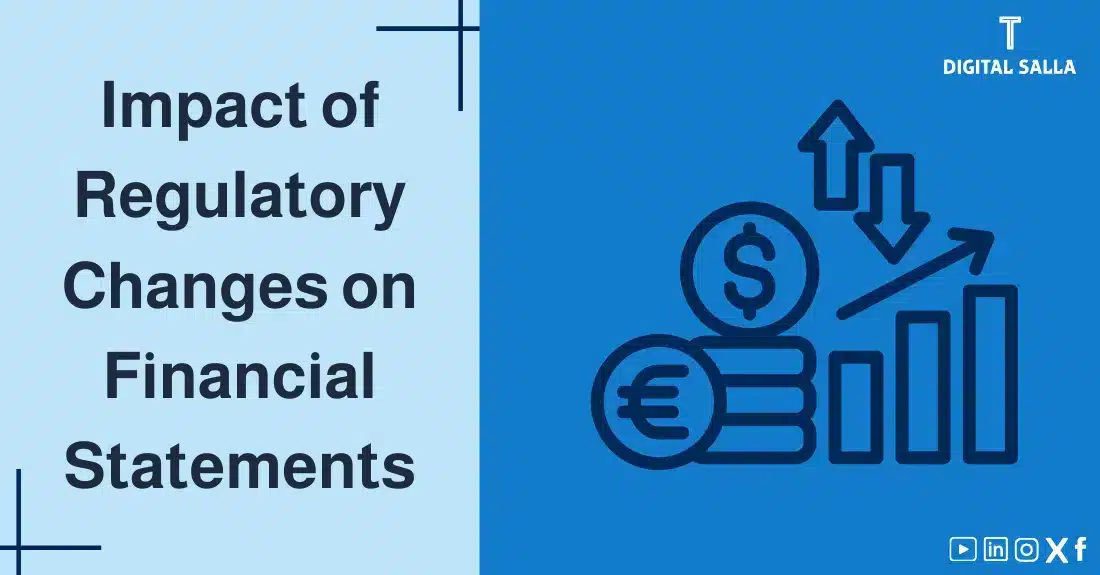Impact of Regulatory Changes on Financial Statements

International Accounting Standard, mainly IFRS, requires companies to reflect the Impact of Regulatory Changes on Financial Statements. These changes directly affect how financial information is prepared and presented, impacting the entity’s performance and financial position. In this article, we will discuss the Impact of Regulatory Changes on Financial Statements, analyzing how these changes can lead to adjustments in accounting policies and accounting estimates, as well as their impact on disclosures. We will also highlight the most important international accounting standards related to this, such as IAS 8 and IFRS 1.
What are Regulatory Changes?
Regulatory changes are any changes in laws, regulations, standards, or rules governing the preparation and presentation of Financial Statements. These changes include:
- Changes in accounting standards: such as the issuance of new International Financial Reporting Standards or amendments to existing standards by the International Accounting Standards Board (IASB).
- Changes in local laws and regulations: such as changes in tax laws, corporate laws, or capital market laws.
- Changes in disclosure requirements: such as imposing new or modified disclosure requirements by regulatory authorities.
Examples of the Impact of Regulatory Changes on Financial Statements:
- IFRS 15, “Revenue from Contracts with Customers”: This standard led to significant changes in how revenue is recognized, affecting the timing and amount of revenue recognition in the Financial Statements of many companies.
- IFRS 16, “Leases”: This standard led to a significant change in the accounting for leases by lessees, requiring them to recognize assets and liabilities for most leases on the Statement of Financial Position.
- IFRS 9, “Financial Instruments”: This standard led to changes in the classification and measurement of financial instruments, and in the expected credit loss model.
- Changes in tax laws: Changes in tax laws can lead to changes in income tax expense and tax liabilities recognized in the Financial Statements.
- Changes in disclosure requirements: Regulatory authorities may impose new disclosure requirements on specific topics, such as risks related to climate change or Environmental, Social, and Governance (ESG) matters, leading to an increase in the volume and scope of disclosures in the Financial Statements. Understanding and adhering to these is a core element in addressing the Impact of Regulatory Changes on Financial Statements.
How Regulatory Changes Affect Financial Statements:
Regulatory changes can affect Financial Statements in multiple ways, including:
- Impact on Recognition and Measurement:
- Regulatory changes may require companies to change how they recognize certain items of assets, liabilities, revenues, and expenses. This necessitates a thorough review of existing processes to ensure compliance and to accurately reflect the Impact of Regulatory Changes on Financial Statements.
- Regulatory changes may lead to changes in the measurement of certain items in the Financial Statements, such as using fair value instead of historical cost.
- Impact on Presentation and Disclosure:
- Regulatory changes may require changes in how certain items are presented in the Financial Statements.
- Regulatory changes may increase the volume and scope of disclosures required in the Financial Statements.
- Impact on Accounting Policies and Accounting Estimates:
- Regulatory changes may require companies to change their Accounting Policies, which can have a material impact on the Financial Statements. It’s vital to carefully consider the pervasive Impact of Regulatory Changes on Financial Statements in these situations.
- Regulatory changes may lead to changes in accounting estimates, such as estimates of the useful lives of assets or depreciation rates.
IAS 8 Standard:
IAS 8, “Accounting Policies, Changes in Accounting Estimates and Errors,” addresses how to deal with changes in accounting policies, changes in accounting estimates, and the correction of errors. IAS 8 provides guidance on:
- Selecting and Applying Accounting Policies: Companies must select and apply Accounting Policies that are appropriate for the nature of their operations and provide reliable and relevant financial information.
- Changes in Accounting Policies: Changes in Accounting Policies must be applied retrospectively, i.e., restating the comparative Financial Statements as if the new policy had always been applied, except in specific cases.
- Changes in Accounting Estimates: The effect of changes in accounting estimates is recognized prospectively, i.e., in the period in which the change occurred and future periods affected.
- Correction of Errors: Material prior period errors must be corrected as soon as possible after their discovery, by restating the comparative Financial Statements for those periods.
IFRS 1 Standard:
IFRS 1, “First-time Adoption of International Financial Reporting Standards,” addresses how companies transition from local accounting standards to IFRS. IFRS 1 provides guidance on how to prepare the opening Financial Statements in accordance with IFRS and how to deal with differences between previous Accounting Policies and the Accounting Policies required by IFRS. This transition often reveals a previously unrecognized Impact of Regulatory Changes on Financial Statements.
Importance of Analyzing the Impact of Regulatory Changes:
Analyzing the Impact of Regulatory Changes on Financial Statements is crucial for the following reasons:
- Understanding the Impact of Changes on Financial Performance: The analysis helps understand how regulatory changes affect the entity’s revenues, expenses, and profitability.
- Assessing the Impact of Changes on Financial Position: The analysis helps understand how regulatory changes affect the entity’s assets, liabilities, and equity.
- Identifying Risks and Opportunities: The analysis helps identify risks and opportunities arising from regulatory changes. It’s impossible to overstate how critical it is to pinpoint the Impact of Regulatory Changes on Financial Statements for risk management.
- Making Informed Management Decisions: The analysis provides valuable information that helps management make decisions about how to respond to regulatory changes. These decisions are heavily influenced by the projected Impact of Regulatory Changes on Financial Statements.
- Communicating with Stakeholders: The analysis helps explain the Impact of Regulatory Changes on Financial Statements to stakeholders, such as investors and creditors. Transparency is key, and the Impact of Regulatory Changes on Financial Statements must be clearly communicated.
How to Analyze the Impact of Regulatory Changes on Financial Statements:
- Identify Relevant Regulatory Changes: Companies must monitor changes in International Financial Reporting Standards and local laws and regulations that may affect the Financial Statements.
- Assess the Impact of Changes on Accounting Policies: Assess whether regulatory changes require changes in the Accounting Policies applied by the company.
- Identify the Impact of Changes on Items of the Financial Statements: Identify the items of the Financial Statements that will be affected by regulatory changes, such as assets, liabilities, revenues, and expenses.
- Measure the Impact of Changes: Measure the financial impact of regulatory changes on the Financial Statements, if possible. Quantifying this is a vital aspect of assessing the overall Impact of Regulatory Changes on Financial Statements.
- Disclose the Impact of Changes: Disclose the Impact of Regulatory Changes on Financial Statements clearly and transparently in the notes to the Financial Statements. This disclosure is fundamental to maintaining trust and is part of the broader Impact of Regulatory Changes on Financial Statements.
Role of Technology in Keeping Up with Regulatory Changes:
Accounting Software and Enterprise Resource Planning (ERP) systems help companies keep up with regulatory changes by:
- Providing Regular Updates to Accounting Standards: Many programs provide automatic updates to accounting standards, helping companies comply with the latest requirements. These updates directly address the Impact of Regulatory Changes on Financial Statements.
- Automating Accounting Processes: Software helps automate accounting processes according to the new standards, reducing the risk of errors and saving time and effort. This automation minimizes disruption caused by the Impact of Regulatory Changes on Financial Statements.
- Generating Financial Reports Compliant with New Standards: Software helps prepare Financial Statements and other financial reports in accordance with the latest International Financial Reporting Standards. Generating compliant reports is a direct response to the Impact of Regulatory Changes on Financial Statements.
- Performing Impact Analyses: Some programs provide tools to analyze the Impact of Regulatory Changes on Financial Statements. This proactive analysis is key to managing the Impact of Regulatory Changes on Financial Statements.
Examples of the Impact of Regulatory Changes:
- Example (1): The IASB issued a new standard requiring companies to recognize all leases on the Statement of Financial Position. This change will lead to a significant increase in the assets and liabilities of companies that use operating leases.
- Example (2): A country amended its income tax law, resulting in a change in the tax rate. This change will affect the income tax expense and net profit in the Income Statement and tax liabilities in the Statement of Financial Position.
- Example (3): A regulatory body imposed new disclosure requirements on risks related to climate change. This will increase the volume and scope of disclosures in the Financial Statements of companies. This exemplifies how disclosure requirements are part of the broader Impact of Regulatory Changes on Financial Statements.
Challenges Facing Companies in Dealing with Regulatory Changes:
- Keeping Up with Constant Changes in Accounting Standards: Companies must continuously monitor updates and amendments to International Financial Reporting Standards to ensure compliance with the latest requirements. These constant updates represent a persistent Impact of Regulatory Changes on Financial Statements.
- Understanding and Interpreting New Requirements: Some International Financial Reporting Standards may be complex and difficult to understand, requiring investment in training and education. The learning curve can be steep when grappling with the Impact of Regulatory Changes on Financial Statements.
- Cost of Implementation: Applying regulatory changes can be costly, especially for small and medium-sized enterprises, as it may require updating accounting systems and training employees. This cost is a direct consequence of the Impact of Regulatory Changes on Financial Statements.
- Need for Specialized Expertise: Companies may need to consult with experts specializing in International Financial Reporting Standards to ensure that regulatory changes are applied correctly.
- Resistance to Change: Some employees or members of management may resist the changes required by regulatory changes, which may hinder the implementation process.
Importance of Cooperation Between Companies and Regulatory Bodies:
Cooperation between companies and regulatory bodies is essential to ensure that regulatory changes are implemented effectively and smoothly. This can be achieved through:
- Participating in the Standard-Setting Process: Companies should participate in the standard-setting process by providing their comments and suggestions to the IASB.
- Communicating with Regulatory Bodies: Companies should communicate with regulatory bodies to better understand the requirements of regulatory changes.
- Obtaining Guidance and Support: Companies should obtain guidance and support from regulatory bodies and professional organizations to overcome the challenges related to applying regulatory changes. Seeking this guidance is a proactive step in managing the Impact of Regulatory Changes on Financial Statements.
Conclusion:
Regulatory changes are an integral part of the contemporary business environment, and companies must be prepared to adapt to these changes to ensure that their financial statements are prepared correctly and in accordance with the latest International Financial Reporting Standards (IFRS).
Understanding the Impact of Regulatory Changes on Financial Statements, along with other influencing factors, is essential for accountants, auditors, investors, and all stakeholders. Through careful planning, investment in training and technology, and collaboration with regulatory bodies, companies can overcome the challenges associated with regulatory changes and ensure the quality and reliability of their financial reports. Finally, analyzing the Impact of Regulatory Changes on Financial Statements helps in making more effective managerial and financial decisions, enhances the transparency and credibility of financial information, and contributes to building trust with investors and supporting economic growth.
